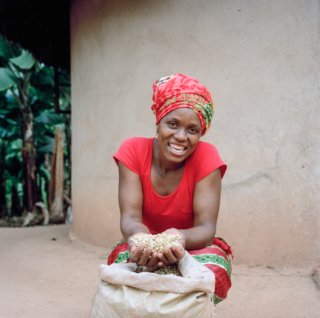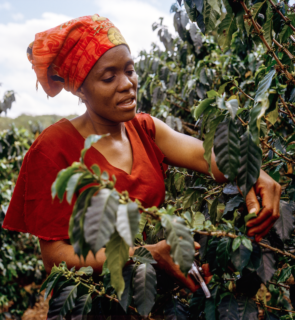In the late 1980s, Zimbabwe enjoyed worldwide fame as a producer of some of the best African coffee. Also, the country was responsible for exporting a product that got coffee-lovers going in the morning. It was of such quality that it could be found in the boardrooms of some of the world’s biggest corporates. However, the failing economy and the effects of climate change have not been kind. By 2017, all that remained were two estates and 450 smallholder farms, leaving the industry in serious decline. The effect on the people responsible for producing the coffee was devastating.
African Coffee Partnership
Now, two years later, Nespresso has partnered with the international non-profit organization TechnoServe. The aim of the partnership is to establish the Reviving Origins project and turn an industry that was at risk of disappearing into an engine for development. Experts believe it has the potential to support thousands of families across the country.
We spoke to Paul Stewart, the global coffee director at TechnoServe. He explained how this project is working to uplift people. They want to empower the very farmers whose parents used to produce coffee in 1980s, before abandoning the crop as it became unviable.
Longevity: Why is the Reviving Origins project in Zimbabwe so important, and how has it helped to have Nespresso involved?
Stewart: The Reviving Origins project is providing the training and market connections that Zimbabwe’s coffee-growers need to profitably grow the crop, ensuring better livelihoods for farming families. And when farmers earn higher incomes, they invest in their children’s education, in better housing, and in improved nutrition for their families.
Nespresso’s role is vital for the success of the initiative. It provides a stable market and premium prices. These incentivize farmers to adopt new techniques to improve the quality and quantity of their harvests.
You’ve been the global coffee director at TechnoServe for almost three years. What are the most notable lessons you’ve learned in this time?
Before I became TechnoServe’s global coffee director, I led the organization’s coffee programs in East Africa. One of the things I’ve learned in this role is the extent to which the majority of coffee farmers across the globe face a set of common challenges. Many of the tools we developed to overcome these challenges in East Africa are applicable across the world. To take one example, the training approach we are using in Zimbabwe – interactive, hands-on, and delivered in small groups – was originally developed for farmers in Tanzania and Rwanda. Now, we are using it not only in Africa but also in Latin America. It has been effective in every country where we’ve used it.
 It’s estimated that about half of the earth’s coffee farmers are located in Africa. What have you found to be the greatest challenges facing truly good-quality African coffee on the continent?
It’s estimated that about half of the earth’s coffee farmers are located in Africa. What have you found to be the greatest challenges facing truly good-quality African coffee on the continent?
Many regions of Africa are blessed with the ingredients needed to produce great, high-quality coffee. These areas have the right climate, altitude, and soils. As the origin of the coffee plant, Africa has the world’s greatest diversity of coffee varieties. Many of these have really exceptional flavors. However, what we often see is that this inherent quality gets lost. This is because farmers haven’t received training on how to properly cultivate or harvest their coffee. In other cases, they don’t have access to processing facilities. As a result, they need to dry their coffee on the ground. Another issue is letting it ferment for too long, which impacts the flavor.
What do you believe should still be done in the future to overcome these challenges?
The good news is that we’ve seen that investment in processing infrastructure and agronomy training can unlock that inherent quality. This can help provide better incomes for African farmers and allow coffee-lovers around the globe to enjoy unique new origins.
In our experience, partnerships across sectors – government, business, and civil society – are a really effective way to facilitate and leverage these investments to generate the greatest impact.
What is the biggest driving force when it comes to building competitive farms, businesses, and industries in developing countries?
People need to be willing to change what they are doing, and helping to build that willingness is an important part of our work.
To take the example of a smallholder farmer, she probably learned how to farm by watching her parents or her neighbors. And she’s been growing African coffee the same way her whole life. When one of our farmer trainers shows her that there’s a different way to treat her plants that will yield larger harvests or better quality, she may be reluctant to change. Not out of stubbornness, but because the coffee farm is her only source of income, and she can’t run the risk of something going wrong.
That’s one reason why we establish demonstration plots in the communities where we work, so farmers can see for themselves that the techniques we are teaching really work.
What are the goals of the project for the future, and what do you hope to achieve in the years to come?
Zimbabwe has the potential to double its coffee production over the next few years, and we are working to support that process. The current program provides agronomy training to more than 250 smallholders. This helps them to improve their productivity and the quality of their coffee.
As we look ahead, we’re working to create an ecosystem that can sustain this positive change, even after our work is complete. For that reason, we are engaging with and helping to build the capacity of farmers, businesses, and government extension agents.
What to look out for
By May 2020, we can look forward to the return of Tamuka mu Zimbabwe. This Arabica African coffee enjoyed tremendous popularity the first time around. In addition, the Reviving Origins program is bringing forward a new coffee from Uganda.
If you are a barista at heart, then you will enjoy this Nespresso recipe.
Honey Almond Milk Coffee
This latte combines fresh, raw honey and frothed almond milk. It’s the perfect warm and toasty way to start the day.
Time: 5 min
Level of difficulty: Easy
Instructions
- Add 2 tsp of honey to cover the bottom of your cup.
- Pour 2 capsules of Livanto into your lungo cup.
- Add 100ml almond milk.
- Sprinkle ½ tsp of cinnamon on top.
- Enjoy!



![women [longevity live]](https://longevitylive.com/wp-content/uploads/2020/01/photo-of-women-walking-down-the-street-1116984-100x100.jpg)










